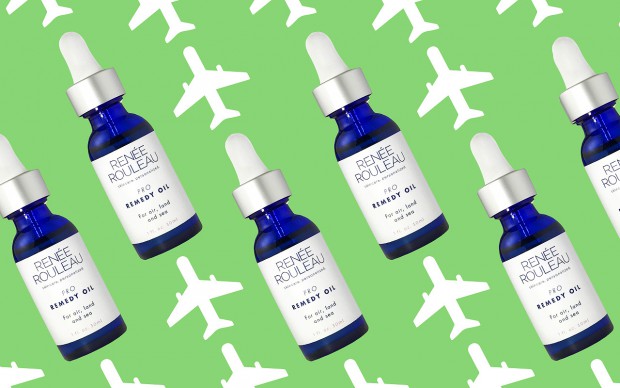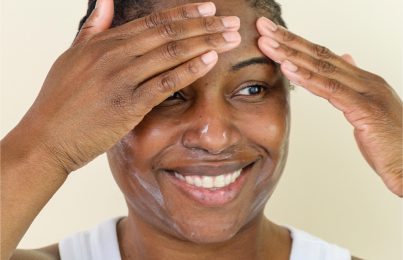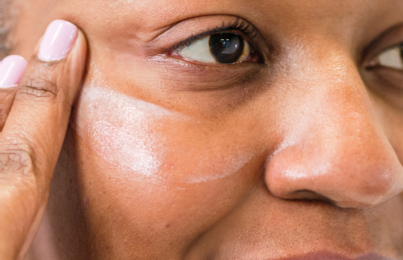Updated 11/10/21. It’s a well-known fact that airplane cabins have extremely low humidity, which can cause extreme dryness and dehydration in the skin. Here’s how it works. Dry air seeks moisture wherever it can find it, which means it will pull it directly from your skin. If you have dry skin, this will make it even drier. If you have oily skin, this will make it even oilier, since your skin will produce even more oil than normal in order to compensate for the loss of water. Simply put, airplanes can wreak havoc for ALL skin types.
That doesn’t mean you should just give up and accept it, because there are multiple things you can do to protect your skin while flying. Keep scrolling to see all of my expert tips to follow before, during, and after a flight for balanced, healthy-looking skin.
What to Do Before a Flight
1. Layer a Hydrating Toner and Serum Over Your Skin
Since airplane cabins have such low humidity, it’s important to load up on as much hydration as possible before your flight. One way to do this is through a layering technique inspired by K-beauty. After cleansing, wipe your skin with a hydrating toner to remove tap water residue. Next, pour a quarter-size amount of Moisture Infusion Toner into the palm of one hand. With your fingertips, pat the toner all over your face. Repeat this process two more times. Finally, apply a water-based serum, like the Skin Drink Concentrate, and apply two more layers of toner over top. Immediately after you’re done layering the toner, apply a generous layer of a sunscreen moisturizer to lock all of the hydration in.
2. Wear Sunscreen
Not only will sunscreen lock hydration from the toner and serum into your skin, but it will protect it from damaging UV rays (airplane windows don’t filter them out!). Remember, even though you’re not in direct sunlight, you’re still being exposed to UV rays. As we all know, UV rays can lead to wrinkles and other signs of skin aging as well as damage. That’s why it’s important to wear a minimum of SPF 30 on your face and neck. I always use the Renée Rouleau Weightless Protection SPF 30.
What to Do During a Flight
1. Apply a Face Oil Every Hour
Applying a few drops of well-formulated face oil every hour during your flight will dramatically help your skin retain moisture. This is seriously effective, especially when it comes to long international flights. An oil, when applied as the last step in your routine, acts as a protective barrier to keep the moisture that’s deep within the skin from evaporating out through the surface. I always use the Renée Rouleau Pro Remedy Oil, and I recommend it to all my frequent-flying clients. Trust me, when you land, your skin will look dewy and radiant. Just be sure to always wash your hands before touching your skin, especially when you’re spending time in busy airports and crowded airplanes.
Note: Applying a face oil over the top of sunscreen can interfere with its protection, so I suggest reserving this trick for longer international flights or nighttime flights. After all, sun exposure is worse than some minor surface dehydration.
I also want to mention protective face coverings, since we’re still required to wear them while on domestic and international flights. Your skin can still get dehydrated while wearing a face covering, but if you’re prone to breakouts, I don’t suggest layering face oil underneath. This could lead to clogged pores. Read more about maskne and how to minimize it.
2. Sit in a Window Seat So You Can Control the Shade
UV light is the enemy of younger-looking skin. In fact, a surprising amount of premature skin aging can be attributed to incidental exposure, which is why you’re skin is exposed to daylight (this is not when you’re intentionally sunbathing). Flying on an airplane is an example of incidental exposure. When you’re in a plane, you’re 30,000 feet closer to the sun. In fact, airline pilots have a higher risk of developing skin cancer since airplane windshields only filter out about 50% of UVA rays. It’s these UV rays that are responsible for damage to cell DNA, which is what leads to premature wrinkles, brown spots, and other visible signs of aging. When you sit in a window seat, you can close the shade to protect your skin. It may seem like a minor thing, but it can make a major difference, especially if you’re a frequent flier.
3. Don’t Use a Face Mist
For years, skincare experts have suggested that a face mist should be a key component of any airplane skincare routine. This is a no-no, for sure! In fact, it’s one of the worst things you can do for your skin. Why? Like I said before, the air is incredibly dry and it will look for water wherever it can find it. When you spray your skin with a hydrating face mist, without layering anything over top to keep the hydration locked in, you’re basically asking the air to draw water out of your skin. The result? Even drier skin than before. That’s why I suggest sticking to my toner and serum layering trick, making sure to seal it all in with a layer of sunscreen.
4. Drink Plenty of Water
It’s always beneficial to keep your body hydrated while flying. While it’s actually the least effective way to hydrate your skin (yes, really!), it’s still important to keep your internal cells hydrated, so bring a water bottle on board.
5. Get Up and Stretch
Again, this isn’t necessarily a tip for your skin, but it’s certainly important for your body. High altitudes can exacerbate circulation problems, which is why it’s a good idea to move around throughout a flight. Don’t sit with your legs crossed, take short walks up and down the aisle, and try to do some light stretching if you can. It will help with your overall blood circulation.
What to Do After a Flight
1. Use a Gentle Face Scrub
When arriving at your destination (hotel, home, or otherwise), cleanse your skin and use a gentle face scrub to remove dry surface cells. Be sure to avoid face scrubs that contain grains such as apricot kernels, walnut husks, and almonds, as the sharp edges can scratch and irritate the skin. Instead, use scrubs that contain natural jojoba beads, such as the Renée Rouleau Mint Buffing Beads. This is also a good trick for boosting circulation to the outer layers of your skin, helping to brighten a tired-looking complexion.
2. Use a Hydrating Face Mask
Once you’ve used your gentle face scrub, reach for a soothing face mask, such as the Renée Rouleau Rapid Response Detox Masque. This is important as it adds essential hydration back into the skin and helps brighten post-flight dullness. I love using gel masks since they have the highest water content. What’s particularly unique about the Rapid Response Detox Masque is that in addition to providing moisture to thirsty skin cells, it also contains blemish-fighting ingredients.
If you have sensitive skin or skin that’s prone to redness, I recommend the Renée Rouleau Bio Calm Repair Masque. It’s cooling, calming, and deeply hydrating. Whichever face mask you choose, leave it on for about 15 minutes, rinse well, and follow up with a moisturizer.
3. Hang Your Head Upside Down
This is my favorite trick for boosting circulation and refreshing a tired-looking complexion! I simply hang my head upside down (whether that’s in a downward dog position or just off the side of my bed) for three minutes. I find that it almost immediately helps improve the look of sluggish, post-flight skin!
4. Keep Your Skincare Routine Consistent
A lot of people pack random free samples they’ve collected and will use them while they’re traveling. I get it, they don’t take up too much space and they’re convenient! However, there’s a potential problem with this. There’s already a lot of change happening. You could be experiencing a new climate, new foods, and a new sleep schedule. The last thing you want to do is switch up your skincare routine, too. Keep things consistent and pack your go-to products. This will help keep your skin calm and clear.
There you have it—a simple airplane skincare routine for happy, hydrated skin no matter where in the world you’re heading!
Next, check out my travel hack for easily packing liquid skincare products in a carry-on bag!
Celebrity Esthetician & Skincare Expert
As an esthetician trained in cosmetic chemistry, Renée Rouleau has spent 35 years researching skin, educating her audience, and building an award-winning line of products. Her hands-on experience as an esthetician and trusted skin care expert has created a real-world solution — products that are formulated for nine different types of skin so your face will get exactly what it needs to look and feel its best. Trusted by celebrities, editors, bloggers, and skincare obsessives around the globe, her vast real-world knowledge and constant research are why Marie Claire calls her “the most passionate skin practitioner we know.”




Comments:
For people with rosacea and sensitivity to harsh/alcohol-based products, what product would you recommend be used as a hydrating moisturizer? I use jojoba oil during the day and sunscreen, but I find my skin is still crying for hydration. Help!
Posted By: Angela |
It would be a good idea to use a daily moisturizer with both oil and water-based hydrating ingredients. You may want to look into Hydraboost Rescue Creme, Phytolipid Comfort Creme or Glow Enhancing Creme!
Posted By: Ella Stevenson |
Would you put oil over your sunscreen, or would the oil cause the sunscreen to be ineffective? How would you continue to keep the skin moisturized hourly without compromising sun protection? Thanks Renée! I love your blog and feel so privileged to have access to your skincare knowledge!
Posted By: Jaymie stroud |
Hi! You can put our Pro Remedy Oil over your sunscreen if needed to keep skin hydrated on the plane. Be sure to close the window shade so you aren’t getting direct sun exposure! You can also reapply SPF by dusting on a powder with sunscreen. Be sure to use our Rapid/Peel Duo when you land to clear out congestion that may have built up during the flight.
Posted By: Renée Rouleau |
As I’ve been averaging 14 longhauls a year, and as an avid Renee Rouleau fan, I’d like to share few “IMHO” observations. Most of your advice is “spot on”. But… Sitting near the window is unlikely to give you more control, as shade settings are dictated by flight attendants in accordance with flight rules, and your seatmates may also have their own opinions. That said… whenever you need to protect your skin, you need to protect your eyes too! I purchased a handy set of sunglasses that fit over reading glasses, and there are transitionals and other solutions to choose. I think the prospect of slathering on a mask at 35,000 feet is a little bit naïve, especially on a crowded flight. You’re in a public space, and it seems a little bit too personal, almost like flossing your teeth in your seat. Again, just my opinion. My skin is oily enough that I walk off an 11-hour flight looking dewy (paltry payback for four decades of acne), but I urge flyers to take along non-drying facial wipes, CC-crème compacts, and other portable products that will permit timely touchups while a line of irritable passengers are getting ready to storm the lavatory door!
Posted By: Hollis Wagenstein-Hurturk |
Hi Im just starting a new job as a flight attendant, do you recommend skin drink as my serum, or intensive firming serum. I always take care of my skin, but now I am worried what constantly flying will do to my skin, please help! Thank you
Posted By: samar |
A skin oil, like our Pro Remedy Oil would be much better for retaining moisture while you’re in the air. You can read about it here. https://www.reneerouleau.com/products/pro-remedy-oil
Posted By: Renée Rouleau |
I’m a healthy fit 48 year old dirty-blond male who now has blotchy poikiloderma below both ears, worse on the L, so it’s not just from driving — I live in Arizona. For decades I have loved sitting “window right, in the back” on airplanes, and I have travelled ALOT, including many longhauls when I fell asleep that way. I’m pretty convinced my love of geography, and the need to see the world from an airplane seat has damaged my skin. I hope this can help any young travellers out there — I wish someone had told me. But man I do have some great pictures of Greenland and Micronesia and the Sahara at sunset from 40,000 feet!
Posted By: Tom Enfermero |
Im due on a long haul flight next month. Im aware of the low humidity in aircraft and hence will be applying an overnight cream mask while flying. But when should i apply suncreen then? Does that mean while im wearing my mask, i will be exposing my face to harmful UVs?
Posted By: Liz |
Just close the window shade but if it’s dark out (meaning no daylight) then you’re not being exposed to harmful UV rays.
Posted By: Renée Rouleau |
That’s a great question. If you are on a long flight (over 6 hours of traveling time) then it could be beneficial to use a cream-based mask. If it’s a shorter flight, I would just leave the skin as is, and treat it post-flight.
Posted By: Renée Rouleau |
Would you recommend putting on a hydrating/moisturizing mask on DURING the flight?
Posted By: kathy wong |
Silicones (those found in makeup primers and skin care products) create a barrier (like plastic wrap) to prevent water from evaporating out of the skin when in a dry environment, like an airplane. No, silicones do not cause acne and are very breathable.
On the other hand, Petrolatum and Mineral Oil also can have the same plastic wrap effect but we find them not to be breathable and find they can cause breakouts.
–Lydia
Posted By: Lydia Noel |
I have read in the past that dimethicone and cyclomethicone (which are silicones) smother the skin like plastic wrap and cause breakouts. Yet you recommend it for hydration. I’m confused. Have you read that or heard that before?
Posted By: Cheryl McCoy |